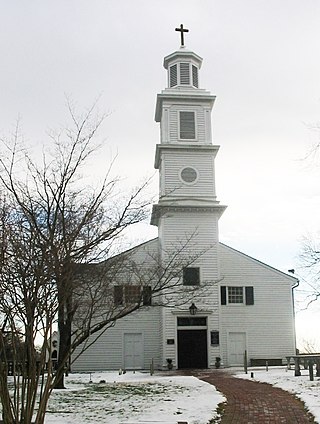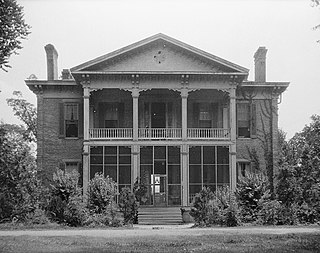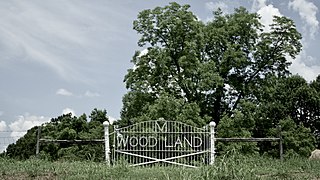
Berkeley Plantation, one of the first plantations in America, comprises about 1,000 acres (400 ha) on the banks of the James River on State Route 5 in Charles City County, Virginia. Berkeley Plantation was originally called Berkeley Hundred, named after the Berkeley Company of England. In 1726, it became the ancestral home of the Harrison family of Virginia, after Benjamin Harrison IV located there and built one of the first three-story brick mansions in Virginia. It is the home to two presidents of the United States: William Henry Harrison, and his grandson Benjamin Harrison. It is now a museum property, open to the public.

The Beauvoir estate, built in Biloxi, Mississippi, along the Gulf of Mexico, was the post-war home (1876–1889) of the former President of the Confederate States of America Jefferson Davis. The National Park Service designated the house and plantation as a National Historic Landmark.
Lorman is an unincorporated community located in Jefferson County, Mississippi, United States. Lorman is approximately 8 miles (13 km) north of Fayette, near Highway 61 on Mississippi Highway 552.

Shadwell is a census-designated place (CDP) in Albemarle County, Virginia. It is located by the Rivanna River near Charlottesville. The site today is marked by a Virginia Historical Marker to mark the birthplace of President Thomas Jefferson. It is listed on the National Register of Historic Places along with Clifton.

St. John's Church is an Episcopal church located at 2401 East Broad Street in Richmond, Virginia, United States. Formed from several earlier parishes, St. John's is the oldest church in the city of Richmond, Virginia. It was built in 1741 by William Randolph's son, Colonel Richard Randolph; the Church Hill district was named for it. It was the site of two important conventions in the period leading to the American Revolutionary War, and is famous as the location where American Founding Father Patrick Henry gave his memorable speech at the Second Virginia Convention, closing with the often-quoted demand, "Give me liberty, or give me death!" The church is designated as a National Historic Landmark.

Church Hill is a small unincorporated community in Jefferson County, Mississippi, United States. It is located eight miles east of the Mississippi River and approximately 18 miles north of Natchez at the intersection of highway 553 and Church Hill Road. Church Hill was a community of wealthy cotton planters and enslaved people before the American Civil War. Soil erosion, which had been going on since well before the Civil War, caused the area to decline into a poor farming community with none of the land under cultivation by 1999. The area is remarkable because its antebellum buildings are mostly intact with few modern buildings having been built.

The I. T. Montgomery House is a historic house on West Main Street in Mound Bayou, Mississippi, United States. Built in 1910, it was the home of Isaiah Montgomery (1847–1924), a former slave of Jefferson Davis who was instrumental in founding Mound Bayou, one of the first economically successful towns established by freed slaves. It was declared a National Historic Landmark in 1976, and a Mississippi Landmark in 2003.

Anchuca, also known as the Victor Wilson House, is a historic Greek Revival house located in Vicksburg, Mississippi, United States. The name is purported to mean "happy home" in the Choctaw language.

Tuckahoe, also known as Tuckahoe Plantation, or Historic Tuckahoe is located in Tuckahoe, Virginia on Route 650 near Manakin Sabot, Virginia, overlapping both Goochland and Henrico counties, six miles from the town of the same name. Built in the first half of the 18th century, it is a well-preserved example of a colonial plantation house, and is particularly distinctive as a colonial prodigy house. Thomas Jefferson is also recorded as having spent some of his childhood here. It was declared a National Historic Landmark in 1969.

Wayside is an unincorporated community in Washington County, Mississippi, United States.
Red Lick is an unincorporated community located in Jefferson County, Mississippi. Red Lick is approximately 5 miles (8.0 km) southeast of Lorman on Mississippi Highway 552.

Pine Ridge is an unincorporated community in Adams County, Mississippi, United States.
Oak Grove is a historic building and estate in Church Hill, Jefferson County, Mississippi, United States.

The Woodland Plantation is a historic Southern plantation near Church Hill, Jefferson County, Mississippi. It retains its original antebellum 230 acre size, and has the tradition of primarily supplying hay to the area cattle. It also has a pecan orchard.
The Wyolah Plantation is a historic Southern plantation in Church Hill, Jefferson County, Mississippi. It is located off the Mississippi Highway 553.

Harriet Byron McAllister Blanton Theobald was an American philanthropist and is referred to as the "Mother of Greenville", Mississippi. She deeded much of her land and right of ways to what became the new site of Greenville, Mississippi after 1865.

The Poplar Grove Plantation, also once known as Popular Grove Plant and Refining Company, is a historic building, site and cemetery, the plantation is from the 1820s and the manor house was built in 1884, located in Port Allen in West Baton Rouge Parish, Louisiana, United States. The site served as a sugar plantation worked by enslaved African Americans, starting in the 1820s by James McCalop. Starting in 1903, the site was owned by the Wilkinson family for many generations.
The Laurel Hill Plantation in Jefferson County, Mississippi near Rodney, Mississippi was a historic plantation. It is located about two miles southeast of Rodney, in a bend of the Mississippi River named "Petit Gulf". It is significant for the architecture of its main plantation house and for the development of Petit Gulf cotton, a cotton hybrid, on its property.














